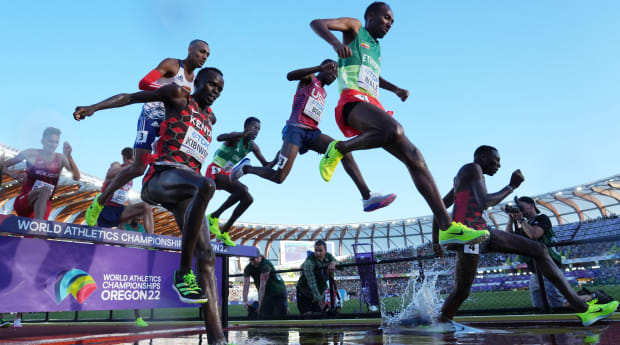
Kirby Lee/USA TODAY Sports
The messy perch that runners flock to sits about 110 miles south of Portland. Drive past the wineries and farms and billboards and dispensaries—so many dispensaries—along with the sign that proclaims Linn County the “grass seed capital of the world.” Exit here, banking into this city of roughly 170,000, with the perfect nickname, TrackTown USA, for an ongoing and unprecedented event. Head east, up the hill from downtown. Turn onto the narrow street that leads into a nondescript neighborhood, winding left, right, then left again.
Follow the GPS, please, because this particular rock is not beautiful in the traditional sense, not sculpted, not striking, not towering. In other words, it’s not easily found. But it does come up on Google Maps, which speaks to its significance, both historically and (especially) this week. Watch out for the dude pedaling uphill on a bicycle, the joggers toiling in packs past recycling bins and the landscapers mowing lawns. Look for the rusted-out van missing wheels and the rhododendron garden at Hendricks Park, then bank right again to remain on Skyline Boulevard.
Finally, there it is. A, um, rock.
Not just any rock, but Pre’s Rock—the one named after legendary runner Steve Prefontaine. It marks the spot where Prefontaine died in a car crash nearly half a century ago. Pre was only 24 on that morning in 1975, but he had already helped spark a running boom with speed and swag and a bevy of U.S. records in distances ranging from 2,000 to 10,000 meters.
Hence why, throughout most of Monday morning, the faithful traveled there, to where he died, forming a steady stream of parishioners at the slice of road affectionately referred to as the Church of Pre. They were young and old, American and Czech and Spanish, trim and athletic, as they trudged up the nearest hill. They walked there, drove there, ran there—dozens of acolytes with little in common beyond this specific pilgrimage.
They came for the slab with Pre’s picture on it—that mustache! The bowl cut! So young! They picked through the items scattered all around, laughing at the beer bottles, studying the pairs of running shoes, saluting the U.S. flag (that someone had placed into an empty IPA can). They saw race bibs. A Pedialyte bottle. Letters. Stickers. A lonely pom. A heart written on rock in red chalk. Many noticed the slogan, a favorite Pre quote, on a blue T-shirt someone had hung behind the slab. “I run to see who has the most guts.” All read aloud the inscription carved under “PRE” on the dark gray stone:
For your dedication and loyalty
To your principles and beliefs …
For your love, warmth, and friendship
For your family and friends …
You are missed by so many,
And you will never be forgotten.
They aren’t here, at this rock, on this morning, just for Pre. They’re here for what he bolstered. For the U.S. city that’s synonymous with track and field. For the history and tradition, Bowerman and Nike, Hayward Field and Agate Street, so many places and people and events and races that led to the first world track championships ever held on U.S. soil. The competition started last Friday and will continue through this weekend in the only place, in the U.S., it should be held.
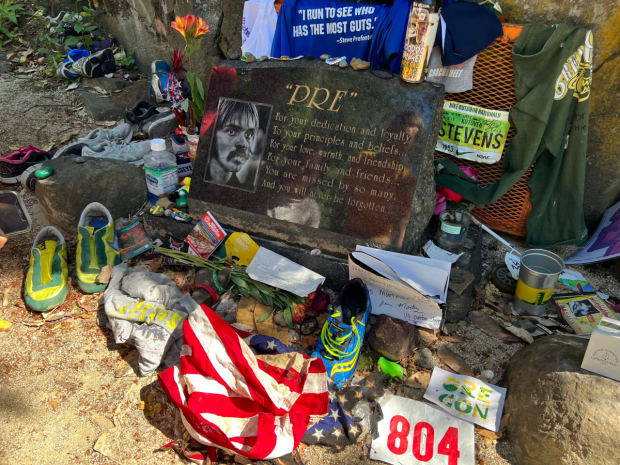
Greg Bishop/Sports Illustrated
Pre’s Rock is a part of that. But only part. Runners clogged the soft bark memorial running trail that bears his name. Fans packed local restaurants, sold out nearby hotels and formed lines outside of sporting goods stores. Even a nearby Weight Watchers was selling merch. Meanwhile, some 2,000 athletes from more than 200 countries traveled to an outpost that’s both an obvious host and an unlikely one. Obvious, because it’s Eugene, it’s track and it’s Hayward Field, a track-only stadium with a seating capacity around 20,000 filled by track types eager to see the nearly $300 million rebuild. Unlikely, because it’s … Eugene.
Since the first world track championships were held in 1983, the competition has crisscrossed the globe, from Helsinki to Rome to Tokyo and, eventually, to Athens, Paris, Berlin, Moscow, Beijing and London, among other places. Big, sprawling, global-power cities, all. Until this year, it had never been held in the United States, which made Eugene’s selection both historic and significant beyond the medals to be won.
This wasn’t just about tourism dollars. Nor was it simply a long-awaited and long-ago-earned spotlight shone on a site competitors have long described with words like magical. The stakes were more important. Like: no less than the sport’s future—and future mainstream popularity, or appeal—in the United States.
Track exists in a weird space in the U.S. sports consciousness. Before these world championships, the U.S. had already seized more than double the total world championship medals of any other nation. By itself, the U.S.’s tally of 170 golds was more than anyone else’s total. And yet, outside of coverage-heavy Olympic years for a handful of star athletes, Team USA’s dominance far outpaces the attention it receives. Hayward Field, home to U.S. national qualifying competitions, became a revered stadium that existed primarily for an insular community.
That changed last week, and in the months of lead-up, and Monday, while the competition continued to unfold. It changed with NBC broadcasts, a worldwide pool of journalists sending dispatches back home and an international reminder that track and field is an easy sport to like and follow. If only more Americans would try it, they would see the athleticism they love in basketball, the speed they love in football and the pack-it-all-in variety unmatched in all the major U.S. sports.
Perhaps, like the Connor family, they would fall in love. The Connors—Margery and her son, Ottati; her brother, Jim, and his wife, Kathy—made the trip from Virginia to Eugene, Hayward and Pre’s Rock. Jim and Kathy were longtime runners who had started in their teens. They had trouble finding lodging before an Airbnb slot opened but no trouble buying tickets down near the track. They had previously attended the world championships in London in 2017, and it never even crossed their mind that they would do the same thing in Oregon—amid an ongoing global pandemic—five years later. They saw how “big” track was in Europe, Kathy says, and how American stars are Gods but only after flying away from their home country.
Kathy still competes in distance races. But while she enjoyed taking in the marathon, was wowed by the female Jamaican sprinters, and felt for U.S. hurdler Devon Allen after he was disqualified right in front of her, she’s not sure this event will bolster wider, mainstream interest. People like her will be thrilled. But those people are already track fans. The newcomers, or casual highlight watchers, are the ones who need to be won over. And to do that, this event, in this place, needed more than to simply be held. It needed to amaze, to stun, to spread knowledge and inspiration.
No worries. This is track, a sport that deploys the world-class of world-class athletes inside a stadium like a pinball machine with dozens of balls sprinting, leaping, throwing and twisting all at once, day after day, until competitors collapse to earned cheers.
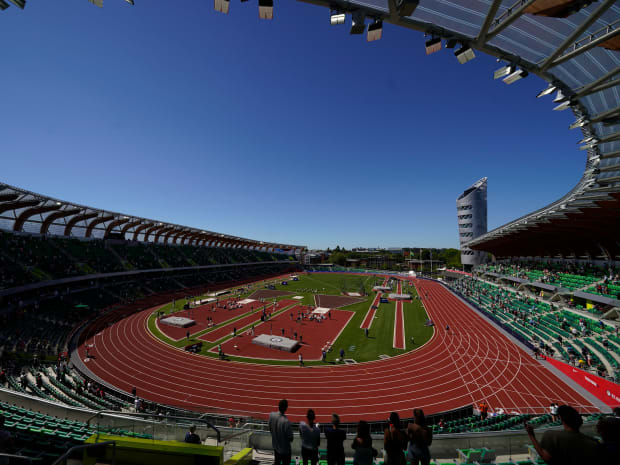
Charlie Riedel/Associated Press
That’s every major track meet. But there’s something else that’s hard to quantify about Hayward Field in Eugene. This was where Bill Bowerman arrived as a freshman at Oregon back in 1929, before giving up football for track and starring at Hayward Field, before serving in the Army in World War II, and coming back to build the U.S.’s most dominant college track program. He began to experiment with equipment, which led to innovations, which made Nike into Nike, which helped transform the U.S. into a nation of joggers.
So there’s the history, as evidenced by Bowerman and the plethora of local businesses with TrackTown in the title. (Although, to be fair, the TrackTown cannabis dispensary missed an easy marketing opportunity with its pre-rolls.) But there’s also the stadium. Fans down near the track sit close enough to Lane 9 to leap into a sprinter if they’d like. This being Oregon, they never do. Instead, they stand and cheer and clap and generally turn a track meet into a celebration.
In order to host the world championships, Nike funded that $270 million renovation, which was completed in 2020, making the largest and most lavish track stadium in the country larger and more lavish, while attempting to retain the aura that organizers—perhaps in an exercise in palatable framing—describe as “intimate.” Anyone still alive when crews broke ground on Hayward Field construction (1919) wouldn’t recognize the current iteration. Same site. Same entrance. Same sport.
Everything else is different. This is a track-only stadium with a video board! The seating bowl is “tipped” so that fans feel like they’re on top of hurdlers crossing the finish line. There’s some sort of 180-foot-tall tower that’s topped by an observation deck with full-circle sight lines, a 40,000-square-foot recovery center underneath the track and a special roof that can open and close and is designed to protect fans from UV rays and rain showers. This is all very Eugene, high-tech and homie—not small-town USA but TrackTown, the temple to running that Phil Knight (and many others) built.
With history in hand, and its stadium upgraded, organizers went to work. Proposals to host were crafted; money, raised; lobbying efforts, embarked upon. Eugene did land the world championships, although COVID-19 pushed the event back a year, in lockstep with the Tokyo Olympics being delayed. Rather than cheer for domestic, college or club athletes, fans from all over but especially here came to see what track and field’s largest non-Olympic stage might look like in their remarkable corner of the sports world.
All everyone needed at that point was a competition that would turn carefully laid plans into a week (and change) that casual U.S. sports fans would remember. Things—moments, wins, epic defeats—that would bring them back.
As usual, track delivered. (Is it obvious yet that the sport won over a certain Sports Illustrated writer last summer in Tokyo?)
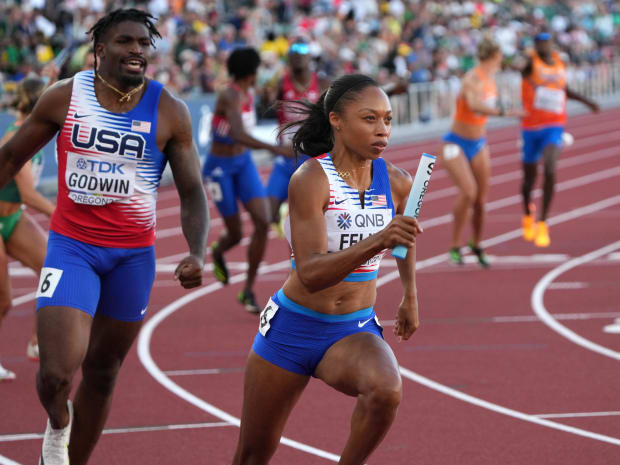
Kirby Lee/USA TODAY Sports
There came Allyson Felix, the sprinter/mom/icon not far removed from her Olympic takeover in Tokyo. Before competing in her final world championship event, she laid out how, over her long career, she had envied athletes in other countries, who sometimes won world medals in front of home crowds. “Come and see the Hayward magic,” she said. “You always feel the energy.” They delivered, and so did she, in the 4X400 mixed relay. Felix ran the second leg, breaking away over her first 200 meters, pushed forward by the crowd. “Really cool. I felt joy running tonight,” she said, after winning a bronze medal, her 19th at one world championship or another, expanding the mark for most ever in the history of women’s track.
“I guess it’s been a long time coming,” she said of that moment, in this place.
She wasn’t alone. The U.S. claimed the 100-meter dash podium on the men’s side, as Fred Kerley narrowly edged two countrymen to become the world’s fastest man and help the U.S. men overcome a disappointing performance in Tokyo. The Jamaican women sprinters put on a show, as the crowd at Hayward gave them their own “home” meet.
On Sunday, the Americans who competed collected nine medals, including four golds, in everything from women’s hammer throw and pole vault to men’s shot put and 110-meter hurdles. This marked the single-greatest, single-day haul for one nation at a world championships and the most golds won by one nation on a single day.
So there it was: history, tradition, upgrades, setting, place, crowds and a competition that beat them all—so far, at least. Yes, COVID-19 still lingered, and the delegation from Japan had a cluster of seven positive cases (two were athletes) early on. But if this is what America’s track future looks like, it’s exciting and potentially landscape-changing. If this backdrop doesn’t draw more eyeballs, more resources and more cash, it’s quite possible nothing beyond a transformative superstar or five will.
That is the mission, from Hayward to Pre’s Rock: to broaden and entice. Same in Los Angeles, where the Olympics will take place in 2028. And at track clubs across the country. The impact is still potential rather than certain, or even likely. But as far as arguments go, this one has been pitch perfect, with almost a week—and some enticing 200-meter dash finals—remaining.
Hopefully this event will at least dent some of the lazy stereotypes in play. Eugene is not a difficult place to get to! No one would say that about Portland, and they’re separated by only 100 miles. Track is not boring! Nonrunners do care! All it takes to understand that is to turn on a television. But it’s not that simple. With track, it never is. The U.S. championships held earlier this summer drew smaller-than-expected crowds that saw a string of subpar performances. NBC went all in, but ESPN, per its own rights agreements, went heavy on the MLB All-Star Game—which, if we’re starting an argument about sports that are boring …
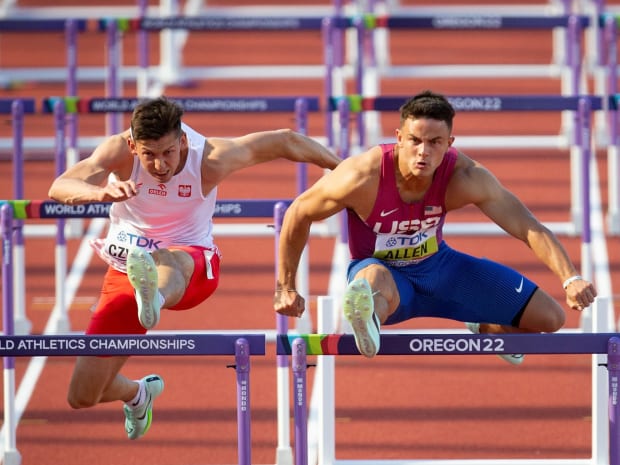
Ben Lonergan/The Register-Guard / USA Today Network
On Monday, at Pre’s Rock and inside Hayward all anyone could talk about was Allen and his DQ the night before. These conversations took place at the food trucks—vegan sandwiches! Crepes!—inside the stadium, at merchandise lines packed with fans. Interest was everywhere, including on Jackie Joyner-Kersee, who held a microphone on the track and told the crowd, “We need resources. We have to invest in our grassroots.”
Allen’s false start was, according to most track experts, a correct ruling. Many believed the rule itself should be changed. Either way, Allen told reporters afterward that he planned to shift his focus to the NFL, where he hopes to make the Eagles’ roster this August. The question that matters now and moving forward is will all the other nontrack die-hards do the same?







